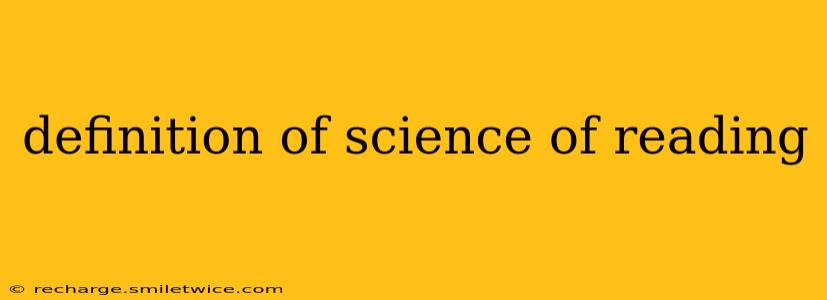The Science of Reading is a research-based approach to teaching reading that emphasizes the importance of phonics, phonemic awareness, vocabulary, fluency, and comprehension. It's not a single method, but rather a framework grounded in decades of scientific research in cognitive science, linguistics, and education. This approach contrasts with older, less effective methods that relied heavily on whole language approaches and often neglected systematic phonics instruction.
The Science of Reading recognizes that reading is a complex cognitive skill that involves multiple interconnected processes. Understanding how these processes work together is crucial for effective reading instruction. Let's delve deeper into the key components:
Key Components of the Science of Reading
1. Phonemic Awareness: This is the ability to hear and manipulate the individual sounds (phonemes) in spoken words. It's a crucial pre-reading skill, as it lays the foundation for understanding the alphabetic principle—the understanding that letters represent sounds. Activities like rhyming, identifying beginning and ending sounds, and blending and segmenting sounds are essential for developing phonemic awareness.
2. Phonics: This involves the relationship between letters and sounds. Systematic and explicit phonics instruction teaches children to decode words by sounding out letters and letter combinations. This is not just about memorizing letter-sound correspondences, but also understanding the patterns and rules that govern English spelling. Effective phonics instruction is crucial for developing reading fluency and accuracy.
3. Vocabulary: A strong vocabulary is essential for reading comprehension. Children need to understand the meaning of words to understand the text they are reading. Vocabulary instruction should involve both direct instruction of new words and opportunities to encounter and use words in context.
4. Fluency: Fluency is the ability to read accurately, quickly, and with expression. Fluent readers can focus on comprehension because they don't have to struggle with decoding individual words. Repeated reading, paired reading, and other fluency-building activities are important for developing reading fluency.
5. Comprehension: This is the ultimate goal of reading—understanding the meaning of the text. Comprehension involves making connections between the text and prior knowledge, making inferences, and monitoring one's understanding. Strategies for improving comprehension include questioning, summarizing, and visualizing.
Frequently Asked Questions (PAAs) about the Science of Reading
What is the difference between the Science of Reading and whole language?
The Science of Reading emphasizes explicit and systematic phonics instruction, while whole language approaches often prioritize meaning-making and immersion in literature, sometimes with less emphasis on systematic phonics. The Science of Reading integrates whole language elements, but it prioritizes a strong foundation in decoding skills as the key to unlocking reading comprehension.
Why is the Science of Reading important?
The Science of Reading is important because it is based on strong scientific evidence. This research shows that explicit and systematic phonics instruction is the most effective way to teach children to read. This approach leads to better reading outcomes for all students, particularly those at risk for reading difficulties.
How can parents support the Science of Reading at home?
Parents can support the Science of Reading at home by engaging in activities that promote phonemic awareness, phonics, vocabulary, fluency, and comprehension. Reading aloud to children, playing rhyming games, practicing sounding out words, and discussing the meaning of words are all effective ways to support reading development. Many resources are available online to help parents implement these activities.
Is the Science of Reading only for struggling readers?
No, the Science of Reading is a beneficial approach for all readers. While it is especially beneficial for students at risk of reading difficulties, a strong foundation in phonics and other reading skills benefits all students, leading to greater reading success and a love of reading.
What are some examples of Science of Reading programs?
There are many different programs that align with the Science of Reading principles. These programs often incorporate systematic phonics instruction, explicit vocabulary teaching, and opportunities for fluency practice and comprehension development. It's important to research and choose programs that align with best practices supported by the research behind the Science of Reading.
By understanding and implementing the principles of the Science of Reading, educators and parents can equip children with the skills they need to become confident, capable readers. This approach ensures that all children have the opportunity to succeed in reading, unlocking a world of opportunities for learning and growth.
